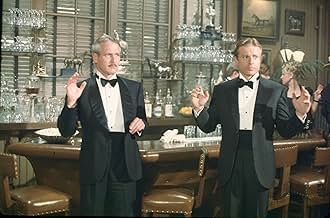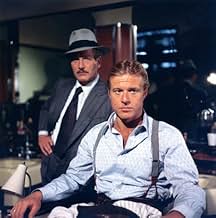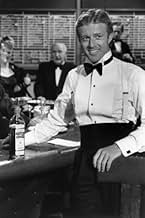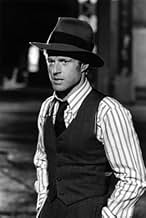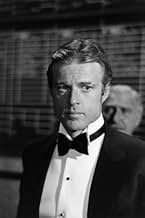Two grifters team up to pull off the ultimate con.Two grifters team up to pull off the ultimate con.Two grifters team up to pull off the ultimate con.
- Won 7 Oscars
- 18 wins & 6 nominations total
Robert Earl Jones
- Luther Coleman
- (as Robertearl Jones)
James Sloyan
- Mottola
- (as James J. Sloyan)
- Director
- Writer
- All cast & crew
- Production, box office & more at IMDbPro
Summary
Reviewers say 'The Sting' is celebrated for its intricate plot, charismatic performances by Paul Newman and Robert Redford, and nostalgic charm of the 1930s setting. The film's clever con schemes, dynamic character interactions, and witty dialogue are frequently highlighted. The iconic ragtime music enhances the atmosphere, while meticulous production design immerses viewers. Despite some criticisms regarding historical inaccuracies and predictability, 'The Sting' is widely regarded as a timeless classic.
Featured reviews
The fix is in, the odds are set, and the boys are ready to play for the big time, both on the screen and behind the camera in this breezy, endlessly entertaining movie classic.
Robert Redford is small-time hustler Johnny Hooker, happy to play the marks in Joliet until the murder of his mentor pushes him to go up against the nastiest mug in Chicago, Doyle Lonnegan (Robert Shaw.) Hooker'd rather ice Lonnegan outright, but will settle for a big con with the help of a slightly wobbly but game scammer named Henry Gondorff, played as only Paul Newman can.
Newman and Redford, along with director George Roy Hill, had a lot riding on this pony, given it was a follow-up to their earlier "Butch Cassidy And The Sundance Kid." To measure up, they had to produce nothing short of another classic. And so they did. "The Sting" won the Best Picture Oscar in 1973, and remains the sentimental favorite among many in choosing between the two films.
Comparing "The Sting" to "Butch Cassidy" is kind of overdone sport, and tempers, as Lonnegan would say, run hot. But you can see why "The Sting" worked as well as it did by looking at how the director and the stars played it differently within the same basic framework as "Butch Cassidy." Newman and Redford are again outlaws and underdogs. Period detail abounds here as it did with "Butch Cassidy," and there's another memorable score amid the proceedings, Scott Joplin rags modernized by Marvin Hamlisch. The score even produced another hit, "The Entertainer," to compare with "Raindrops Keep Falling On My Head."
What's different about "The Sting," and what makes it such a classic in its own right, is the way the stars service the plot. In "Butch Cassidy," Newman and Redford's comradeship was the story. Here, the chemistry between the two actors is minimized in favor of spinning a yarn with enough red herrings to feed the Swedish navy. The tale here is better than "Butch Cassidy," which is a more elegiac film with grander cinematography and funnier set pieces. "The Sting" is an edge-of-your-seat caper flick from beginning to end.
You can't really call "The Sting" a comedy. Though there are many laughs, especially when Newman hooks Shaw during a poker game, Hill won't let the audience relax enough for that. What this is is a con game, played on the audience, designed not to cheat but entertain by means of clever hoodwinking and constant misdirection plays.
You'll get no spoilers from me. This is one worth sitting through with no expectations. Five gets you ten you'll enjoy Newman and Redford, and a terrific supporting cast (one advantage over "Butch Cassidy") that includes Charles Durning, Eileen Brennan, Dana Elcar, Harold Gould, and Mr. Hand himself, Ray Walston. There's another familiar face from "Butch Cassidy," Charles Dierkop, Flat Nose Curry in "Butch Cassidy" and Lonnegan's right hand here. The best performance may be Robert Shaw's; he exudes menace aplenty but some humanity, too, when he takes Hooker under his wing after learning he came from the same hard streets of Five Points Lonnegan sprang from.
Terrific period detail, too. The dialogue is great and feels real in its Runyonesque way, while the cons are elaborate and logically played out. Watching this a second time is especially fun because once you know how the plot goes down, you find yourself catching clues you missed the first time, and enjoying the film even more for them.
Why didn't Newman and Redford team up again? Certainly there was another good movie for them to partner up in, but as Gondorff would have put it, only chumps don't quit when they're ahead.
Robert Redford is small-time hustler Johnny Hooker, happy to play the marks in Joliet until the murder of his mentor pushes him to go up against the nastiest mug in Chicago, Doyle Lonnegan (Robert Shaw.) Hooker'd rather ice Lonnegan outright, but will settle for a big con with the help of a slightly wobbly but game scammer named Henry Gondorff, played as only Paul Newman can.
Newman and Redford, along with director George Roy Hill, had a lot riding on this pony, given it was a follow-up to their earlier "Butch Cassidy And The Sundance Kid." To measure up, they had to produce nothing short of another classic. And so they did. "The Sting" won the Best Picture Oscar in 1973, and remains the sentimental favorite among many in choosing between the two films.
Comparing "The Sting" to "Butch Cassidy" is kind of overdone sport, and tempers, as Lonnegan would say, run hot. But you can see why "The Sting" worked as well as it did by looking at how the director and the stars played it differently within the same basic framework as "Butch Cassidy." Newman and Redford are again outlaws and underdogs. Period detail abounds here as it did with "Butch Cassidy," and there's another memorable score amid the proceedings, Scott Joplin rags modernized by Marvin Hamlisch. The score even produced another hit, "The Entertainer," to compare with "Raindrops Keep Falling On My Head."
What's different about "The Sting," and what makes it such a classic in its own right, is the way the stars service the plot. In "Butch Cassidy," Newman and Redford's comradeship was the story. Here, the chemistry between the two actors is minimized in favor of spinning a yarn with enough red herrings to feed the Swedish navy. The tale here is better than "Butch Cassidy," which is a more elegiac film with grander cinematography and funnier set pieces. "The Sting" is an edge-of-your-seat caper flick from beginning to end.
You can't really call "The Sting" a comedy. Though there are many laughs, especially when Newman hooks Shaw during a poker game, Hill won't let the audience relax enough for that. What this is is a con game, played on the audience, designed not to cheat but entertain by means of clever hoodwinking and constant misdirection plays.
You'll get no spoilers from me. This is one worth sitting through with no expectations. Five gets you ten you'll enjoy Newman and Redford, and a terrific supporting cast (one advantage over "Butch Cassidy") that includes Charles Durning, Eileen Brennan, Dana Elcar, Harold Gould, and Mr. Hand himself, Ray Walston. There's another familiar face from "Butch Cassidy," Charles Dierkop, Flat Nose Curry in "Butch Cassidy" and Lonnegan's right hand here. The best performance may be Robert Shaw's; he exudes menace aplenty but some humanity, too, when he takes Hooker under his wing after learning he came from the same hard streets of Five Points Lonnegan sprang from.
Terrific period detail, too. The dialogue is great and feels real in its Runyonesque way, while the cons are elaborate and logically played out. Watching this a second time is especially fun because once you know how the plot goes down, you find yourself catching clues you missed the first time, and enjoying the film even more for them.
Why didn't Newman and Redford team up again? Certainly there was another good movie for them to partner up in, but as Gondorff would have put it, only chumps don't quit when they're ahead.
I agree 100 percent that this is a wonderful movie. I first saw it over 30 years ago, and it remains vivid in my mind while I can't remember zip about movies I saw last week which others have praised and I found wanting. I can't think of another film about double and triple crosses that deserves to be mentioned in the same sentence with "The Sting" (which doesn't mean that some of the others haven't been good). In addition to all the things that others have praised, one of the most memorable features of this film is the use of a Scott Joplin rag, which both lends a distinctive period touch and adds a sense of fast-paced motion to the action. I'm not much for ranking films -- top five, top ten, top 250 -- but this is one of the best. If you haven't already seen it, drop everything and find the DVD. As pure entertainment, it can't be beat.
In Joliet, Illinois in 1936 the murder of a 'grifter' causes repercussions throughout the underworld. Grifters are the small-time con artists who work the streets. They know and respect one another, and the death of Luther brings all the con men from far and wide together in a plan of revenge. Doyle Lonnegan is the New York Irish gangster who ordered Luther's execution, so the grifters target him for the "big con".
"The Sting" was devised as a follow-up to "Butch Cassidy", reuniting Newman and Redford as lovable, wisecracking rogues. The motivation behind the project may have been cynical box-office manipulation, but the resulting film is a beauty. The two stars make a great team, and multi-faceted confidence tricks adorn the plot in Byzantine complexity.
Lonnegan (Robert Shaw) has two prominent personality traits - greed and cruelty. A con is put together which will use these characteristics against their owner. The best way to hurt Lonnegan is to dupe him out of his money, because the sharks of the criminal fraternity will turn on him once they see that he's been 'had'. It is essential that Lonnegan must never know that this was a scam, because if he did, he would pursue a vendetta against our heroes. He must believe that he lost his money through his own stupidity, and that the men who took it are now dead.
The opening scenes emphasise the harshness of a world in which powerful crooks fleece ordinary joes, but also stress the warmth of the social bond which unites the small-time thieves. Mottola is a runner for Lonnegan's operation, a heartless dandy who steals a desperate man's dough (or so he thinks). The gambling dens ruthlessly swindle Hooker out of his money, but Hooker makes no trouble for the croupier, a guy just like himself who is merely trying to survive.
Redford plays Hooker to perfection. He is the handsome, charming 'man of the people'. There is no malice in him, and yet he spends his life ducking, diving and dodging lead. Luther was his father figure, and we see Hooker transfer his filial allegiance to Gondorff.
The film is crammed with technical cleverness. Whoever went out and scouted for locations did a great job, because the gritty 1930's look is wonderful. If the streets around the bookie's shop were 'faked' on a back lot, then this alone would make "The Sting" outstanding. Watch the urban period detail as Lonnegan goes across to place his first bet, and again at the start of "The Wire". Hooker suddenly realises that Luther is dead, and we see 'the penny drop' by means of a very simple but very effective device - the camera zooms back. No redundant dialogue, no over-acting. The panoramic view from above the rail tracks is achieved by 'masking in' a photograph of old Joliet, to create a convincing skyline. During the poker game on the train, the focus is thrown from Lonnegan's cards to Gondorff's eyes. We know that Gondorff knows that Lonnegan is cheating.
The music cannot go unmentioned. Apart from being exquisite, it contributes a major part of the film's overall feel. "The Sting" introduced the piano rags of Scott Joplin to a mass audience, and their popularity has not diminished over the ensuing decades. Composed perhaps forty years before the events they illustrate, and therefore 'wrong' from a period point of view, the pieces are none the less perfect, and the film is unimaginable without them. As a fun accompaniment to the music, the film contains various silent-era 'wipes'. Watch for the changes of scene for the iris-ins and iris-outs, and vertical and horizontal wipes.
David Ward's script is intelligent and intricate. The 'big con' has safety features built into it, such as the well-worked 'shut-out'. In order for the audience to take the swindlers to their hearts, it is necessary to depict the cops as venal, immoral and downright sleazy. Local dick Snyder is all of this, and more, his character being a masterpiece of dimwitted malevolence.
Eileen Brennan (Captain Lewis in "Private Benjamin") plays Billie, Gondorff's partner. She turns in a performance of cool assurance, one of the film's subtler treats. Charles Dierkop is simply marvellous as Floyd. This veteran of "Butch Cassidy" has hardly any dialogue, but he makes Floyd central to the film's comic purpose - and does it all with nuances of gesture. The FBI agents are great. Wearing straw boaters more than a decade after straw boaters ceased to be cool, and persisting with them even in torrential rain, the G-men are the archetype of Hooverian 'squareness'.
It may be fanciful, but are there passing references to Hitchcock's "Strangers On A Train"? The carrousel may be stretching a point, but what of Mottola's feet at the start, wearing Robert Walker's shoes?
"The Sting" is a splendid film. The plot may perform bewildering gyrations, Robert Shaw's Irish accent may be somewhat shaky, and Solino may be an assassin too far - but the whole of this complicated contraption works, and works well. I can recall, back in 1974, an excited cinema audience actually cheering and shouting at the screen.
"Seems worthwhile, doesn't it?"
"The Sting" was devised as a follow-up to "Butch Cassidy", reuniting Newman and Redford as lovable, wisecracking rogues. The motivation behind the project may have been cynical box-office manipulation, but the resulting film is a beauty. The two stars make a great team, and multi-faceted confidence tricks adorn the plot in Byzantine complexity.
Lonnegan (Robert Shaw) has two prominent personality traits - greed and cruelty. A con is put together which will use these characteristics against their owner. The best way to hurt Lonnegan is to dupe him out of his money, because the sharks of the criminal fraternity will turn on him once they see that he's been 'had'. It is essential that Lonnegan must never know that this was a scam, because if he did, he would pursue a vendetta against our heroes. He must believe that he lost his money through his own stupidity, and that the men who took it are now dead.
The opening scenes emphasise the harshness of a world in which powerful crooks fleece ordinary joes, but also stress the warmth of the social bond which unites the small-time thieves. Mottola is a runner for Lonnegan's operation, a heartless dandy who steals a desperate man's dough (or so he thinks). The gambling dens ruthlessly swindle Hooker out of his money, but Hooker makes no trouble for the croupier, a guy just like himself who is merely trying to survive.
Redford plays Hooker to perfection. He is the handsome, charming 'man of the people'. There is no malice in him, and yet he spends his life ducking, diving and dodging lead. Luther was his father figure, and we see Hooker transfer his filial allegiance to Gondorff.
The film is crammed with technical cleverness. Whoever went out and scouted for locations did a great job, because the gritty 1930's look is wonderful. If the streets around the bookie's shop were 'faked' on a back lot, then this alone would make "The Sting" outstanding. Watch the urban period detail as Lonnegan goes across to place his first bet, and again at the start of "The Wire". Hooker suddenly realises that Luther is dead, and we see 'the penny drop' by means of a very simple but very effective device - the camera zooms back. No redundant dialogue, no over-acting. The panoramic view from above the rail tracks is achieved by 'masking in' a photograph of old Joliet, to create a convincing skyline. During the poker game on the train, the focus is thrown from Lonnegan's cards to Gondorff's eyes. We know that Gondorff knows that Lonnegan is cheating.
The music cannot go unmentioned. Apart from being exquisite, it contributes a major part of the film's overall feel. "The Sting" introduced the piano rags of Scott Joplin to a mass audience, and their popularity has not diminished over the ensuing decades. Composed perhaps forty years before the events they illustrate, and therefore 'wrong' from a period point of view, the pieces are none the less perfect, and the film is unimaginable without them. As a fun accompaniment to the music, the film contains various silent-era 'wipes'. Watch for the changes of scene for the iris-ins and iris-outs, and vertical and horizontal wipes.
David Ward's script is intelligent and intricate. The 'big con' has safety features built into it, such as the well-worked 'shut-out'. In order for the audience to take the swindlers to their hearts, it is necessary to depict the cops as venal, immoral and downright sleazy. Local dick Snyder is all of this, and more, his character being a masterpiece of dimwitted malevolence.
Eileen Brennan (Captain Lewis in "Private Benjamin") plays Billie, Gondorff's partner. She turns in a performance of cool assurance, one of the film's subtler treats. Charles Dierkop is simply marvellous as Floyd. This veteran of "Butch Cassidy" has hardly any dialogue, but he makes Floyd central to the film's comic purpose - and does it all with nuances of gesture. The FBI agents are great. Wearing straw boaters more than a decade after straw boaters ceased to be cool, and persisting with them even in torrential rain, the G-men are the archetype of Hooverian 'squareness'.
It may be fanciful, but are there passing references to Hitchcock's "Strangers On A Train"? The carrousel may be stretching a point, but what of Mottola's feet at the start, wearing Robert Walker's shoes?
"The Sting" is a splendid film. The plot may perform bewildering gyrations, Robert Shaw's Irish accent may be somewhat shaky, and Solino may be an assassin too far - but the whole of this complicated contraption works, and works well. I can recall, back in 1974, an excited cinema audience actually cheering and shouting at the screen.
"Seems worthwhile, doesn't it?"
A delicious wheeze from start to finish. Certainly a film that leaves you thinking that you'd like to have been in Henry's gang and played a part in separating Lonnegan from his dough. The editing is pin sharp and beautifully cast with a superb musical track to keep you company. The framing, the photography, the pace all dovetail exquisitely and if you feel left outside of the game plan in your first viewing, never fear, the second time of watching, you'll enjoy it just as much but it will mean more. Certainly it's a film you'll want to see a second time. At least. Oscars rightly by the handful and nominations are full deserved to combine for a winning performance by all concerned. Definitely in my top fifty of all time.
10moman818
A magical plot, dead on art direction, brilliant supporting roles (most notably Robert Shaw, ya falla?), and the guiding hand of Redford/Newman chemistry make this one of the Hollywood's great films. "The Sting" is a hallmark of the "Golden Age" of American film, and has molded not only countless films, but numerous genres, few of which have met the challenge of its master.
Oscars Best Picture Winners, Ranked
Oscars Best Picture Winners, Ranked
See the complete list of Oscars Best Picture winners, ranked by IMDb ratings.
Did you know
- TriviaPaul Newman and Robert Redford were each paid $500,000 for their role, the highest rate for an actor working at that time. Adjusted for inflation, that is equal to about $3 million (2022). The year before this Marlon Brando earned $3 million from Le Dernier Tango à Paris (1972) but that included profit participation.
- GoofsIn the bathroom, Hooker can be seen saying, "He didn't tell me you was a fuck-up either." This has been looped to replace it with the less profane "He didn't tell me you was a screw-up either." (The grammar error is scripted.)
- Quotes
Johnny Hooker: Can you get a mob together?
Henry Gondorff: After what happened to Luther, I don't think I can get more than two, three hundred guys.
- Crazy creditsThe opening animated logo for Universal Pictures is in 1930s style, matching the movie's setting, instead of the 1970s version.
- ConnectionsFeatured in Oscars, Actors and The Exorcist (1974)
Details
Box office
- Budget
- $5,500,000 (estimated)
- Gross US & Canada
- $156,000,000
- Gross worldwide
- $156,000,000
- Runtime2 hours 9 minutes
- Color
- Aspect ratio
- 1.85 : 1
Contribute to this page
Suggest an edit or add missing content




